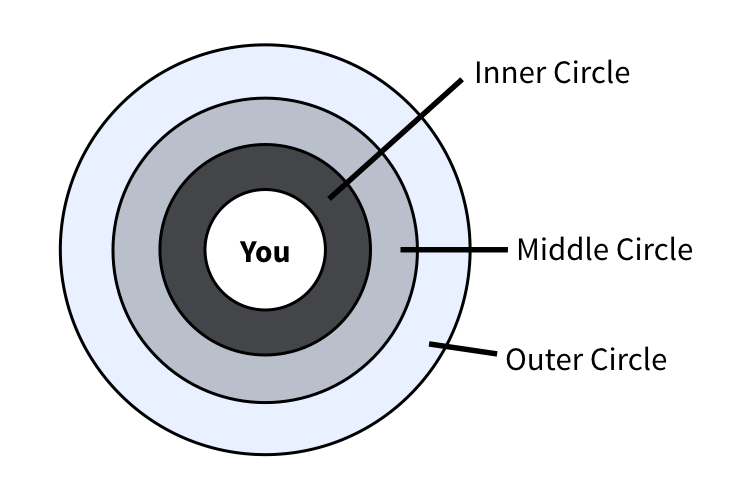- Toolkits
- Are You Ready to Talk?
- Beyond the Line
- Blocking Gender Bias
- Edgy Veggies
- First-Gen Ascend
- Fishbowl Discussions
- Measuring Mobility
- Peaceful Politics
- Plot the Me You Want to Be
- RaceWorks
- Rethinking Stress
- Space Reface
- Team Up Against Prejudice
- United States of Immigrants
- Kit Companion: Map Your Identities
- Kit Companion: LARA
- Collections
- Action Areas
- About
Hierarchical Mapping Technique
Measuring Mobility Toolkit > Measure Selector > Hierarchical Mapping Technique
Hierarchical Mapping Technique
Factor: Being Valued in Community
Age: Adult
Duration: 3-5 minutes
Reading Level: 6th-8th grade
What
Psychologist Toni Antonucci (1986) developed the Hierarchical Mapping Technique to measure the number and strength of respondents’ relationships.
Who
Researchers have given the Hierarchical Mapping Technique to people from a variety of ethnic and socioeconomic backgrounds, including Americans living on a low income (Antonucci, 1986; Antonucci, Airouch, & Birditt, 2014).
How
INSTRUCTIONS
On a picture with three concentric circles and the word “YOU” in the center, respondents list the names of important people in their lives according to how close they feel to them. The inner circle is for “people to whom you feel so close that it is hard to imagine life without them.” The middle circle is for “people to whom you may not feel quite that close but who are still important to you.” The outer circle includes “people whom you haven’t already mentioned but who are close enough and important enough in your life that they should be placed in your personal network.”

RESPONSE FORMAT
Open-ended responses.
Think of the three circles below as including people who are important in your life right now, but who are not equally close. Read the descriptions below and list the people you think fit into each circle based on how close you feel with that person.
Inner Circle: People to whom you feel so close that it is hard to imagine life without them.
Middle Circle: People to whom you may not feel quite that close but who are still important to you.
Outer Circle: People whom you haven’t already mentioned but who are close enough and important enough in your life that they should be placed in your personal network.

Why It Matters
The number and strength of people’s relationships — their social networks — both reflect and affect their social standing. For instance, more educated people have larger social networks than do less educated people (Ajrouch, Blandon, & Antonucci, 2005). Having larger social networks, in turn, increases social mobility by giving people access to more information and opportunities (Granovetter, 1983; Montgomery, 1991). In addition, less educated people with larger social networks have fewer health problems than do those with smaller social networks (Antonucci, Ajrouch, & Janevic, 2003), removing illness as an obstacle to upward mobility.
HEADS UP
Although research shows that larger, looser social networks promote social mobility, no study has yet used the Hierarchical Mapping Technique to demonstrate this relationship.
References
Ajrouch, K. J., Blandon, A. Y., & Antonucci, T. C. (2005). Social networks among men and women: The effects of age and socioeconomic status. Journal of Gerontology: Social Sciences, 60B(6), 5311-5317.
Antonucci, T. C. (1986). Measuring social support networks: Hierarchical mapping technique. Generations, 10-12.
Antonucci, T. C., & Akiyama, H. (1987). Social networks in adult life and a preliminary examination of the convoy model. Journal of Gerontology, 42(5), 519-527.
Antonucci, T. C., Ajrouch, K. J., & Birditt, K. S. (2014). The convoy model: Explaining social relations from a multidisciplinary perspective. The Gerontologist, 54(1), 82-92.
Antonucci, T. C., Ajrouch, K. J., & Javenic, M. R. (2003). The effect of social relations with children on the education-health link in men and women aged 40 and over. Social Science & Medicine, 56(5), 949-960.
Granovetter, M. (1983). The strength of weak ties: A network theory revisited. Sociological Theory, 1, 201-233.
Kahn, R. L., & Antonucci, T. C. (1980). Convoys over the life course: Attachment, roles, and social support. In P. B. Baltes & O. Brim (Eds.), Life-Span Development and Behavior (vol. 3, 253–286). New York: Academic Press.
Montgomery, J. D. (1991). Social networks and labor-market outcomes: Toward an economic analysis. The American Economic Review, 81(5), 1408-1418.

